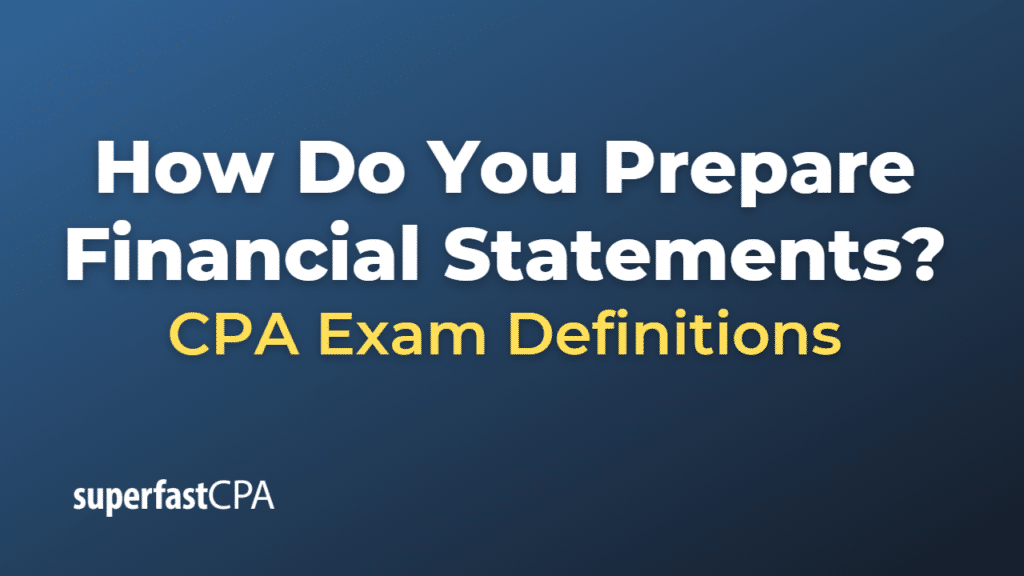Prepare Financial Statements
Preparing financial statements is a multi-step process that involves compiling and analyzing a company’s financial transactions. It generally involves these steps:
- Record Financial Transactions: All financial transactions that the business has engaged in during the accounting period should be recorded in the company’s books, primarily through the use of journal entries. This system is based on the double-entry bookkeeping principle, meaning for every debit entry, there must be a corresponding credit entry.
- Post to Ledger Accounts: Journal entries are then posted to ledger accounts. The ledger organizes the same transactions by account, so you can see the total for each account.
- Prepare a trial balance: A trial balance is prepared to verify the total debits equal the total credits from all the accounts. If the trial balance doesn’t balance, errors must be found and corrected.
- Make Adjusting Entries: These are made at the end of the accounting period to record all amounts that have been earned or incurred but are not yet recorded. This includes entries for expenses incurred but not yet paid, revenues earned but not yet billed, and depreciation and amortization of assets.
- Prepare an Adjusted Trial Balance: A new trial balance is prepared after considering the adjusting entries. This adjusted trial balance is used to generate the financial statements.
- Prepare Financial Statements: Use the adjusted trial balance to prepare the financial statements. Typically, the income statement is prepared first, followed by the statement of retained earnings, the balance sheet, and finally, the statement of cash flows.
- Prepare Closing Entries: After the financial statements are completed, closing entries are made. This involves moving all revenue and expense account balances to the income summary account, and then transferring the net income (or loss) and dividends to the retained earnings account. This resets the balances of the revenue and expense accounts to zero for the next accounting period.
- Prepare a Post-Closing Trial Balance: This is the last step in the accounting cycle. It’s prepared to ensure all revenue and expense accounts have been properly reset for the next accounting period.
These steps provide a broad overview of the process for preparing financial statements. In practice, the process is typically more complex and may require the use of accounting software or consultation with a professional accountant or financial advisor, especially for larger businesses or those with more complex financial situations.
Example of Prepare Financial Statements
Let’s consider a simple example with a fictional company, “BookStore Inc.”, to illustrate the steps in preparing financial statements.
- Record Financial Transactions: BookStore Inc. records all its financial transactions during the month, such as sales, purchases of inventory, wages, rent, utilities, and any other business-related expenses.
- Post to Ledger Accounts: The company then posts these transactions to the appropriate ledger accounts, like cash, accounts receivable, inventory, sales, accounts payable, wages expense, rent expense, and utilities expense.
- Prepare a Trial Balance: BookStore Inc. prepares a trial balance to verify that total debits equal total credits.
- Make Adjusting Entries: At the end of the month, BookStore Inc. records adjusting entries. For example, they may need to record accrued wages for the last days of the month, or to account for the depreciation of assets.
- Prepare an Adjusted Trial Balance: After recording adjusting entries, the company prepares an adjusted trial balance.
- Prepare Financial Statements: From the adjusted trial balance, BookStore Inc. prepares its financial statements:
- Income Statement: This shows revenues, expenses, and net income (or loss) for the month. For example, sales of $10,000, less costs of goods sold of $6,000, gives a gross profit of $4,000. After deducting operating expenses such as wages, rent, and utilities, the net income might be $1,000.
- Statement of Retained Earnings: This shows the changes in retained earnings during the month. It starts with the opening balance of retained earnings, adds the net income, and subtracts any dividends paid, to arrive at the closing balance of retained earnings.
- Balance Sheet: This shows the company’s assets, liabilities, and equity at the end of the month. Assets might include cash, accounts receivable, and inventory. Liabilities might include accounts payable. Equity includes common stock and the ending balance of retained earnings from the statement of retained earnings.
- Statement of Cash Flows: This shows the inflow and outflow of cash during the month from operating, investing, and financing activities.
- Prepare Closing Entries: After preparing the financial statements, BookStore Inc. prepares closing entries. This involves moving all revenue and expense account balances to the income summary account, and then transferring the net income (or loss) and dividends to the retained earnings account.
- Prepare a Post-Closing Trial Balance: Finally, BookStore Inc. prepares a post-closing trial balance to ensure all revenue and expense accounts have been properly reset for the next accounting period.
This example simplifies a complex process, but it gives you an idea of the steps involved in preparing financial statements.













